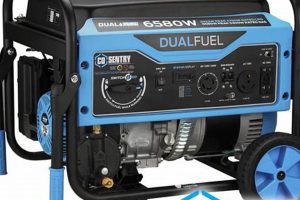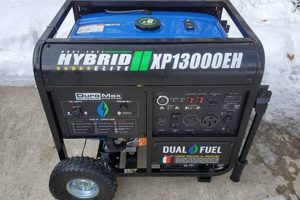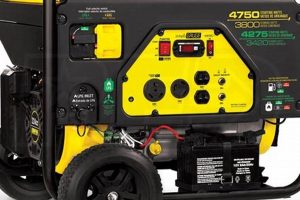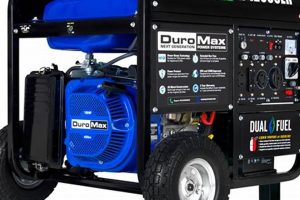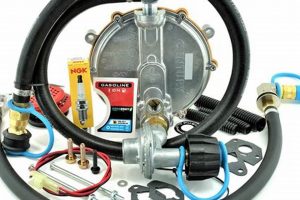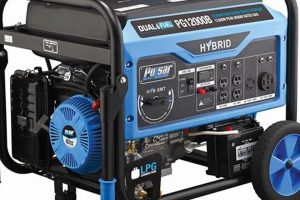Compact, independent power sources designed for mobility and lower fuel consumption represent a significant advancement in power generation technology. These devices typically utilize advanced engine designs and technologies, such as inverter technology, to maximize energy conversion while minimizing fuel usage. An example includes units powered by propane or gasoline, engineered to deliver consistent electricity with reduced emissions and extended runtimes on a single tank.
The need for reliable, yet economical, power solutions has driven the development of these generators. Reduced operating costs, extended runtimes, and a smaller environmental footprint are key advantages. Historically, portable power generation often meant sacrificing efficiency for portability. Modern advancements, however, allow users to have both, benefiting various applications from recreational activities to emergency preparedness and professional work sites. Lower fuel consumption also translates to fewer refueling trips, enhancing convenience and reducing downtime.
The subsequent sections will delve into specific types of these power sources, explore key factors to consider during selection, and discuss best practices for safe and efficient operation.
Tips for Selecting and Operating Portable Generators Efficiently
Choosing and using a portable generator wisely involves careful consideration of several factors to maximize efficiency and ensure safe, reliable operation. The following tips offer guidance for informed decision-making and responsible usage.
Tip 1: Calculate Power Requirements: Accurately assess power needs before purchasing a unit. Consider the wattage requirements of devices intended for simultaneous operation to avoid overloading the generator.
Tip 2: Prioritize Inverter Technology: Inverter generators offer superior fuel efficiency and cleaner power output compared to conventional models, making them ideal for sensitive electronics.
Tip 3: Consider Fuel Type and Availability: Evaluate available fuel options (e.g., gasoline, propane, dual-fuel) based on cost, accessibility, and storage capabilities.
Tip 4: Match Generator Size to Needs: Avoid oversized generators. While larger units offer greater power output, they consume more fuel even when operating below capacity. Select a size appropriate for typical usage.
Tip 5: Adhere to Maintenance Schedules: Regular maintenance, including oil changes and air filter cleaning, is crucial for optimal performance and fuel efficiency. Refer to the manufacturer’s recommendations for specific maintenance intervals.
Tip 6: Operate at Optimal Load: Generators typically achieve peak fuel efficiency when operating at approximately 50-75% of their rated capacity. Avoid consistently running the generator at very low loads.
Tip 7: Utilize Eco-Mode (if available): Many modern generators feature an “eco-mode” or similar setting that automatically adjusts engine speed based on load, optimizing fuel consumption.
By following these guidelines, users can significantly improve the efficiency of their portable generators, reducing fuel costs and minimizing environmental impact while ensuring a reliable power supply.
These operational and selection strategies contribute to a more sustainable and cost-effective approach to portable power generation. The following conclusion summarizes the key benefits and reinforces the importance of responsible generator usage.
1. Inverter Technology
Inverter technology plays a crucial role in the enhanced efficiency of modern portable generators. Unlike conventional generators that operate at a fixed speed, inverter generators adjust engine speed dynamically to match the power demand. This variable speed operation is central to fuel efficiency and improved power quality.
- Variable Speed Control
Conventional generators maintain a constant engine speed, often around 3600 RPM, regardless of the load. Inverter generators, however, use electronic circuitry to monitor power demand and adjust engine speed accordingly. This dynamic adjustment minimizes fuel consumption, especially at lower loads, where significant fuel savings can be achieved.
- Clean Power Output
Inverter technology produces a cleaner, more stable sine wave output. This “clean power” is essential for sensitive electronic devices, such as laptops, smartphones, and medical equipment, protecting them from potential damage caused by voltage fluctuations common in conventional generators. The cleaner output results from the conversion of AC power to DC and then back to AC, filtering out harmonic distortions.
- Reduced Noise Levels
The variable speed operation of inverter generators contributes to significantly lower noise levels compared to conventional generators. At lower loads, the engine runs at a reduced speed, minimizing noise pollution. This feature is particularly beneficial in noise-sensitive environments, such as campsites or residential areas during power outages.
- Increased Portability
Inverter generators are generally smaller and lighter than conventional generators of comparable power output. The compact design and lighter weight enhance portability, making them easier to transport and store. This is a significant advantage for applications requiring mobile power solutions, like recreational activities or emergency preparedness.
The integration of inverter technology in portable generators marks a significant advancement in power generation efficiency and overall performance. By dynamically adjusting engine speed, delivering clean power, reducing noise, and enhancing portability, inverter generators offer a superior solution for various applications demanding both power and efficiency. The benefits extend beyond fuel savings to include environmental responsibility and improved user experience.
2. Fuel Consumption Rates
Fuel consumption rates represent a critical metric for evaluating the efficiency of portable generators. Expressed typically in gallons per hour (GPH) or liters per hour (LPH), this measurement directly correlates with operating costs and the overall environmental impact. Lower fuel consumption rates translate to reduced fuel expenses and fewer emissions, making this a primary consideration for users seeking economical and environmentally responsible power solutions. A generator consuming 0.5 GPH, for example, will operate twice as long on a given amount of fuel compared to a generator consuming 1.0 GPH, showcasing the practical significance of this metric. This has substantial implications for both the frequency of refueling and the long-term cost of ownership.
Understanding fuel consumption rates enables informed decision-making during generator selection. Manufacturers typically provide fuel consumption data at various load levels, offering insight into how the generator performs under different operating conditions. Comparing these rates across different models allows users to identify the most fuel-efficient options that align with their power requirements. For instance, a generator with a lower GPH rating at a typical operating load of 50% will provide longer runtimes and reduce fuel costs compared to a model with a higher GPH at the same load. This understanding empowers users to optimize operational efficiency and minimize environmental impact.
Minimizing fuel consumption not only reduces operational costs but also contributes to a smaller environmental footprint. Lower fuel consumption directly translates to reduced greenhouse gas emissions, aligning with environmentally conscious practices. Furthermore, less frequent refueling contributes to greater convenience, particularly in remote locations or during extended power outages. Selecting a generator with a low fuel consumption rate supports both economic and environmental sustainability, crucial for responsible power generation.
3. Runtime Capacity
Runtime capacity, a crucial characteristic of portable generators, denotes the duration a generator can operate continuously on a full tank of fuel. This duration, often measured in hours, directly correlates with fuel efficiency. A higher runtime capacity signifies that the generator can sustain operation for extended periods without refueling, a critical factor in various applications, particularly during prolonged power outages or in remote locations where refueling is inconvenient or impossible. Generators with larger fuel tanks and those designed for higher fuel efficiency typically offer longer runtimes, enabling users to rely on a consistent power supply for extended durations.
The relationship between runtime capacity and fuel efficiency is intertwined. While a larger fuel tank contributes to extended runtime, it does not necessarily indicate higher fuel efficiency. A fuel-efficient generator maximizes the energy extracted from each unit of fuel, resulting in a longer runtime even with a smaller tank. For instance, two generators with identical fuel tank capacities might have vastly different runtimes if one utilizes inverter technology for enhanced fuel efficiency, allowing it to operate significantly longer on the same amount of fuel. Therefore, considering both tank size and fuel efficiency provides a comprehensive understanding of a generator’s true runtime capacity.
Understanding runtime capacity is essential for selecting the appropriate generator for specific needs. Emergency preparedness scenarios, for example, often necessitate extended runtimes to power essential appliances and devices during prolonged power outages. Similarly, outdoor recreational activities or remote work sites benefit from generators capable of providing sustained power without frequent refueling interruptions. Evaluating runtime capacity alongside fuel efficiency empowers users to choose a generator that aligns with their power demands and usage patterns. This careful consideration ensures a reliable power supply for the required duration, minimizing disruptions and maximizing operational efficiency.
4. Engine Design
Engine design plays a pivotal role in the overall efficiency of portable generators. Optimizations in combustion processes, component integration, and engine control mechanisms directly impact fuel consumption and operational performance. Advanced engineering principles are employed to maximize energy conversion and minimize waste, resulting in generators that deliver reliable power while consuming less fuel. Understanding these design elements is essential for selecting a generator that balances performance with efficiency.
- Combustion Efficiency
Modern fuel-efficient generators often incorporate advanced combustion systems designed to maximize the energy extracted from fuel. High-compression ratios, optimized air-fuel mixtures, and advanced ignition systems contribute to more complete combustion. This results in less wasted fuel and reduced emissions. For example, stratified combustion engines precisely control fuel injection and ignition timing to enhance combustion efficiency, particularly at lower loads. This focus on maximizing the energy released from each combustion cycle is a cornerstone of fuel-efficient engine design.
- Overhead Valve (OHV) Design
Many fuel-efficient portable generators utilize Overhead Valve (OHV) engine designs. Positioning the valves in the cylinder head allows for more efficient airflow into and out of the combustion chamber. This optimized airflow improves combustion efficiency and contributes to smoother engine operation, further enhancing fuel economy and reducing emissions. The OHV design simplifies maintenance as well, improving long-term reliability and performance.
- Engine Speed Control
Advanced engine speed control mechanisms play a crucial role in fuel efficiency. Inverter generators, in particular, leverage variable speed technology, adjusting engine RPM based on power demand. This dynamic adjustment ensures the engine operates at the optimal speed for the given load, minimizing fuel consumption, especially at partial loads. By avoiding unnecessary high-speed operation, these generators significantly reduce fuel waste and extend runtimes. Conventional generators, lacking this feature, operate at a fixed speed, often leading to higher fuel consumption when operating below capacity.
- Friction Reduction
Minimizing internal friction within the engine is a crucial aspect of fuel-efficient design. High-quality bearings, precision-machined components, and advanced lubrication systems reduce frictional losses, allowing more of the fuel’s energy to be converted into usable power. This focus on minimizing friction contributes to smoother operation, improved fuel economy, and reduced wear on engine components, extending the generator’s operational lifespan.
The interplay of these engine design elements significantly influences the overall fuel efficiency of portable generators. From optimized combustion processes to advanced speed control and friction reduction, these factors contribute to generators that deliver reliable power while minimizing fuel consumption and environmental impact. Understanding these design considerations enables informed selection and contributes to a more sustainable approach to portable power generation.
5. Operational Efficiency
Operational efficiency in fuel-efficient portable generators encompasses practices and features that maximize power output while minimizing fuel consumption. This optimization is crucial for cost-effective operation, extended runtimes, and reduced environmental impact. Understanding the factors contributing to operational efficiency empowers users to make informed decisions regarding generator selection and usage, ultimately enhancing the overall value and sustainability of portable power generation.
- Load Management
Effective load management is paramount for optimizing operational efficiency. Operating a generator at its optimal load range, typically between 50% and 75% of rated capacity, ensures peak fuel efficiency. Avoid exceeding the generator’s capacity or running it consistently under very light loads. Prioritizing essential appliances and staggering usage can help maintain optimal loading. For example, running a refrigerator and a few lights simultaneously may achieve higher efficiency than running only a small fan. Careful load management significantly extends runtimes and reduces fuel costs.
- Maintenance Practices
Adhering to recommended maintenance schedules is crucial for sustained operational efficiency. Regular oil changes, air filter cleaning or replacement, and spark plug inspection ensure the generator operates at peak performance. Neglecting maintenance can lead to decreased fuel efficiency, reduced power output, and potentially costly repairs. For example, a clogged air filter restricts airflow to the engine, reducing combustion efficiency and increasing fuel consumption. Regular maintenance is an investment in long-term operational efficiency and generator longevity.
- Fuel Quality and Storage
Using fresh, clean fuel and proper fuel storage practices contribute to optimal operational efficiency. Stale or contaminated fuel can hinder engine performance and reduce fuel efficiency. Storing fuel in approved containers, away from direct sunlight and extreme temperatures, prevents degradation and maintains fuel quality. Using fuel stabilizers can further extend the storage life of fuel, especially during periods of infrequent generator usage. Proper fuel management practices safeguard the generator’s engine and contribute to consistent, efficient operation.
- Operating Environment
The generator’s operating environment can influence its efficiency. High altitudes and extreme temperatures can impact engine performance and fuel consumption. Ensuring adequate ventilation around the generator is essential for optimal combustion and cooling. Operating the generator on a stable, level surface promotes efficient engine operation and reduces vibration. Consideration of environmental factors contributes to consistent performance and maximizes fuel efficiency in various operating conditions.
These operational efficiency factors, when considered collectively, contribute significantly to the overall performance and cost-effectiveness of fuel-efficient portable generators. Implementing these practices maximizes fuel economy, extends runtimes, reduces emissions, and prolongs the generator’s operational lifespan. By understanding and applying these principles, users can achieve a more sustainable and economically sound approach to portable power generation.
Frequently Asked Questions
This section addresses common inquiries regarding fuel-efficient portable generators, providing concise and informative responses to facilitate informed decision-making and responsible generator usage.
Question 1: How is fuel efficiency measured in portable generators?
Fuel efficiency is typically measured in gallons per hour (GPH) or liters per hour (LPH), indicating the amount of fuel consumed per hour of operation. Lower values signify higher fuel efficiency.
Question 2: What is the significance of inverter technology in fuel efficiency?
Inverter technology allows the generator to adjust engine speed dynamically based on power demand, leading to significant fuel savings, especially at lower loads. It also produces cleaner power output, safe for sensitive electronics.
Question 3: How does generator size impact fuel efficiency?
Oversized generators consume more fuel even when operating below capacity. Selecting a generator appropriately sized for the intended load maximizes fuel efficiency.
Question 4: How does maintenance affect fuel efficiency?
Regular maintenance, such as oil changes and air filter cleaning, is essential for optimal engine performance and fuel efficiency. Neglecting maintenance can lead to increased fuel consumption and reduced generator lifespan.
Question 5: What role does fuel type play in generator efficiency?
Different fuel types (e.g., gasoline, propane, diesel) have varying energy densities and combustion characteristics, impacting overall efficiency. Consider fuel availability, cost, and storage requirements when selecting a generator.
Question 6: How can one optimize generator load for maximum fuel efficiency?
Generators typically operate most efficiently at 50-75% of their rated capacity. Avoid consistently running the generator under very light loads or exceeding its maximum capacity to optimize fuel consumption.
Careful consideration of these frequently asked questions empowers consumers to make informed decisions regarding the selection and operation of fuel-efficient portable generators. Understanding these fundamental aspects contributes to responsible generator usage, maximizing both economic and environmental benefits.
For further information and specific product details, please consult manufacturer specifications and authorized dealer resources.
Fuel Efficient Portable Generators
Fuel efficient portable generators represent a significant advancement in power generation technology. This exploration has highlighted the multifaceted nature of these devices, encompassing engine design, fuel consumption rates, runtime capacity, inverter technology, and operational best practices. The convergence of these factors contributes to generators capable of delivering reliable power while minimizing fuel consumption and environmental impact. From recreational activities to emergency preparedness and professional applications, the versatility of these generators underscores their importance in a world increasingly reliant on portable power solutions.
As technology continues to evolve, further advancements in fuel efficiency and emission reduction are anticipated. The demand for sustainable power solutions will continue to drive innovation in this field, shaping the future of portable power generation. Careful consideration of the factors discussed herein empowers consumers to make informed decisions, selecting generators that align with both individual needs and broader environmental stewardship goals. The transition towards more sustainable power solutions is underway, and fuel efficient portable generators play a pivotal role in this transformative journey.

